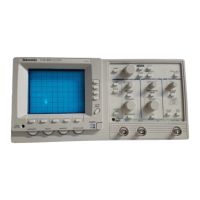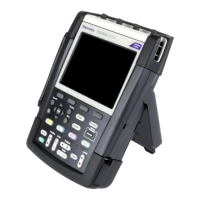Quick Start
4.
Now
two horizontal bar cursors are displayed. The active (movable) one
is
a solid line and the inactive one
is
a dashed line. Use the General
Purpose
Knob to move the active cursor and use the TOGGLE button to
select which cursor
is
active.
Position Active
Cursor
Active
Cursor...........
0
~~~~~~~~~~~O~·.·.···
c::::>
0%
•••••••••••••••••••••••••••••••••••••••
l--LJ
,."".",.
....•....•..
~
ClEAR
MENU
@
l~~
Active
Cursor
Connecting a Signal
The
TAS
475 and
TAS
485 Oscilloscopes accept signals through the front
panel input connectors labeled CH
1,
CH 2, CH
3,
and CH
4.
The probes
you use for taking measurements
should only be those supplied with the
TAS
475 and
TAS
485 Oscilloscopes. Connecting signals to the
TAS
475
and
TAS
485 Oscilloscopes is also possible with the use of 50 Q coaxial
cables.
Using AUTOSET
2-4
Before using any probe to take measurements, compensate the probe to
match the input
channel. See Compensating the Probe on page 2-5.
The
AUTOSET feature
of
the
TAS
475 and
TAS
485 Oscilloscopes automati-
cally
sets most
of
the front panel controls.
1.
Connect the probe compensation signal (from the PROBE COMP
connector on the front panel) to either channel of the oscilloscope and
display that channel (see Figure 2-5). Turn all other channels off.
2.
Press the AUTOSET button on the front panel. Wait one to three sec-
onds to
allow the instrument to adjust all the control settings.
The instrument
will trigger on the waveform, display at least one complete
cycle,
and center it horizontally on the
CRT.
The baseline of the waveform
will be at the center horizontal graticule line. The intenSity level
is
increased if
set
too
low for a viewable display.
Operation
•
•
•
